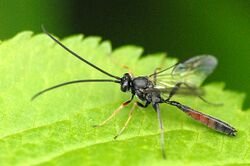Biology:Dusona leptogaster
| Dusona leptogaster | |
|---|---|

| |
| Dusona leptogaster | |
| Scientific classification | |
| Domain: | Eukaryota |
| Kingdom: | Animalia |
| Phylum: | Arthropoda |
| Class: | Insecta |
| Order: | Hymenoptera |
| Family: | Ichneumonidae |
| Genus: | Dusona |
| Species: | D. leptogaster
|
| Binomial name | |
| Dusona leptogaster Holmgren, 1860
| |
Dusona leptogaster is a species of parasitic wasp belonging to the family Ichneumonidae, subfamily Campopleginae.[1] It is a parasitoid of Geometrid moth larvae, the two known hosts being Alsophila aescularia and Lomaspilis marginata.[2]
Description
Head, antennae and thorax black. Central abodominal segments red, basal and posterior segments black. Coloration of legs varies. Petioloar suture complete. First gastral sternite coriaceous medially. Mesopleuron with wrinkles and without punctuation centrally, densely rugose-punctate dorsally and ventarally (some small specimens might be rugose-punctate centrally). Third gastral tergite separated from the epipleuron by a crease. Median longitudinal carinae of propodeum complete anteriorly. Size 7–8 mm, 38–43 flagellomeres. D.leptogaster is very similar to other small species of Dusona such as Dusona nidulator, Dusona admontina and Dusona terebrator but can be distinguished by a combination of the sculpture of the mesopleuron, the coloration of abdomen, the number of flagellomeres and other smaller characteristics.[3][4]
Ecology
Dusona leptogaster is a known parasitoid of two species of Geometrid moth: Alsophila aescularia and Lomaspilis marginata. The wasp seems to be either bivoltine or univoltine depending on its host. D. leptogaster larvae kill their host during its pupal stage and then spin a cocoon inside the now hollow pupa. The adult wasp emerges the following year. Flight period is between May and September.[2]
Distribution
Dusona leptogaster is known from most of the palearctic region: Austria, Azerbaijan, Belgium, Bulgaria, Croatia, Czech Republic, Finland, France, Germany, Hungary, Italy, Japan, Latvia, Moldova, Netherlands, Poland, Romania, Russia (including east Siberia), Sweden, Switzerland, Turkey, Ukraine and United Kingdom.[2][4]
References
- ↑ Taxapad Ichneumonoidea. Yu D.S.K., 4 May 2009
- ↑ 2.0 2.1 2.2 Horstmann, K (2011). "Verbreitung und Wirte der Dusona-Arten in der Westpaläarktis (Hymenoptera, Ichneumonidae, Campopleginae)". Linzer biologische Beiträge 43: 1295-1330. https://www.zobodat.at/pdf/LBB_0043_2_1295-1330.pdf.
- ↑ Horstmann, Klaus (2009). "Revision of the western Palearctic species of Dusona Cameron (Hymenoptera, Ichneumonidae, Campopleginae)". Spixiana 32: 45-110. https://www.zobodat.at/pdf/Spixiana_032_0045-0110.pdf.
- ↑ 4.0 4.1 Meier, Noah I.; Urfer, Karin; Haraldseide, Håkon; Vårdal, Hege; Klopfstein, Seraina (2022). "Open access in a taxonomic sense: a morphological and molecular guide to Western Palaearctic Dusona (Hymenoptera, Ichneumonidae)". Journal of Hymenoptera Research. https://jhr.pensoft.net/article/83318/element/4/468//.
Wikidata ☰ Q2106344 entry
 |

